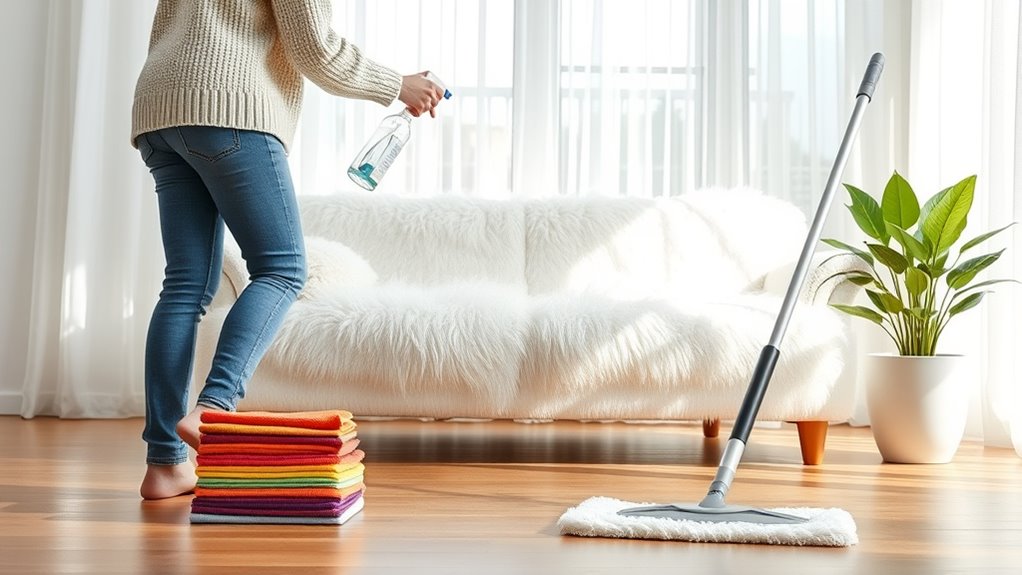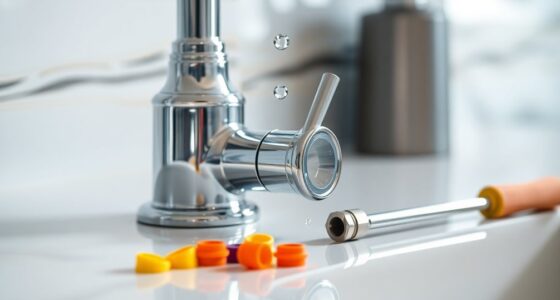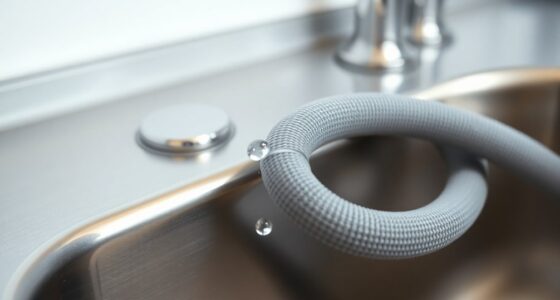To deep clean your home effortlessly, start by organizing your supplies with labeled containers and eco-friendly products. Tackle one area at a time, such as the kitchen or bathroom, using microfiber cloths and natural disinfectants. Declutter surfaces and keep things tidy with smart storage solutions. Regular maintenance like washing cloths and inspecting appliances keeps your space fresh. Keep in mind, incorporating these easy strategies guarantees a cleaner home—continue for even more expert tips.
Key Takeaways
- Organize cleaning supplies with labeled, eco-friendly containers for quick access and sustainability.
- Tackle one room at a time, starting with the kitchen and then moving to other areas.
- Declutter surfaces by sorting items into keep, donate, or discard piles before deep cleaning.
- Use natural disinfectants and plant-based cleaners to ensure effective, safe cleaning.
- Create a relaxing post-clean environment with organized spaces and entertainment options like a home projector.

Spring is the perfect time to refresh your home, and a well-organized cleaning checklist can make the task much easier. One of the best ways to streamline your deep cleaning process is by incorporating effective organizing tips. Start by gathering all your cleaning supplies and sorting them into categories. Use clear storage bins or labeled containers to keep everything accessible and visible. This not only saves time but also keeps your space tidy and clutter-free, making your cleaning routine smoother. When organizing your cleaning supplies, consider eco-friendly products. These environmentally conscious choices reduce your home’s chemical footprint and are safer for your family and pets. Look for natural disinfectants, biodegradable scrubbers, and plant-based cleaning solutions, which are just as effective as conventional products without the harmful effects.
Organize cleaning supplies with clear bins and eco-friendly products for a safer, tidier home.
As you begin your deep clean, focus on one area at a time to avoid feeling overwhelmed. For example, tackle the kitchen first by clearing countertops, wiping down appliances, and scrubbing sinks with eco-friendly degreasers. Use microfiber cloths, which are reusable and cut down on paper waste, to dust surfaces and clean glass. When you’re done, make a habit of storing your cleaning tools neatly in a designated caddy or drawer, so they’re ready for next time. This organization tip keeps your cleaning routine efficient and prevents clutter from creeping back in. Additionally, regularly inspecting and maintaining your bike components, such as brakes and tires, can help prevent unexpected breakdowns during your outdoor activities. Proper maintenance can also extend the lifespan of your bike and ensure safety during rides.
Next, move on to the living areas and bedrooms. Declutter by sorting items into keep, donate, and discard piles. This helps you see what you truly need and reduces unnecessary clutter. When cleaning surfaces, opt for eco-friendly multi-surface cleaners to eliminate dirt and germs without exposing yourself to harsh chemicals. Remember, using sustainable products isn’t just good for the environment—it’s better for your health too. After dusting and vacuuming, consider replacing your regular vacuum bags with washable filters or bags made from recycled materials. Keep in mind that UV protection during outdoor cleaning or activities can also safeguard your skin from potential damage if you spend time outside after tidying up indoors.
In addition, choosing a high-quality home projector with good contrast ratio and color accuracy can enhance your viewing experience during relaxing movie nights after your cleaning session. Bathrooms often require deep scrubbing, especially around sinks, tubs, and toilets. Use eco-friendly bathroom cleaners that are powerful enough to remove soap scum and mildew but gentle enough to be safe for sensitive skin. Keep your brushes and cloths separate, and wash them regularly to prevent bacteria buildup. Organizing your bathroom essentials in baskets or wall-mounted holders can make daily maintenance easier and quicker. Regularly check and replace your Glycolic Acid products as part of your skincare routine to maintain healthy skin after your deep clean, since clean skin is better prepared to absorb skincare treatments effectively.
Frequently Asked Questions
What Are Eco-Friendly Cleaning Products for Spring Cleaning?
When choosing eco-friendly cleaning products, you look for options with natural ingredients that are safe for your family and the environment. You can also use reusable supplies like cloths and spray bottles to reduce waste. These products often come in biodegradable packaging and avoid synthetic chemicals, making your spring cleaning safer and more sustainable. By switching to natural ingredients and reusable supplies, you make a positive impact on your home and the planet.
How Do I Remove Stubborn Stains Effectively?
Tackling stubborn stains can feel like fighting a losing battle, but with the right stain removal techniques, you can win. Start by identifying the stain type and applying targeted stubborn stain solutions, like a mixture of baking soda and vinegar or commercial stain removers. Gently blot rather than rub, and repeat if necessary. Patience and persistence are your best allies in conquering even the toughest stains.
What Tools Are Essential for Deep Cleaning?
You need essential tools for deep cleaning, including reliable cleaning gadgets that make stain removal easier. A good vacuum, microfiber cloths, scrub brushes, and a steam cleaner are must-haves. For stubborn stains, keep stain removal sprays and baking soda handy. These tools help you target dirt and grime efficiently, ensuring every surface gets thoroughly cleaned. Investing in quality cleaning gadgets makes deep cleaning faster, more effective, and less frustrating.
How Can I Organize Cleaning Supplies Efficiently?
You can organize your cleaning supplies efficiently by using smart storage solutions like stackable bins or portable carts. Label organization is key—write clear labels for each container so you know exactly what’s inside. Keep frequently used items within easy reach, and store less-used supplies elsewhere. Regularly declutter and reassess your setup to maintain an organized system that makes deep cleaning quicker and less stressful.
When Is the Best Time to Start Spring Cleaning?
Imagine your home as a garden waiting for renewal; the best time to start spring cleaning is when the first blooms emerge, signaling fresh growth. You should follow seasonal tips and set a cleaning schedule aligned with the changing weather. Usually, late winter or early spring is ideal. This way, you’re nurturing your space, ensuring it’s refreshed and ready to flourish all season long.
Conclusion
Now that you’ve tackled your spring cleaning, your home feels refreshed and revitalized. With this easy checklist, you’ve made the task manageable and even enjoyable. Isn’t it amazing how a deep clean can lift your spirits and create a more inviting space? Keep up the momentum, and your home will stay sparkling all season long. Are you ready to enjoy the benefits of a cleaner, happier home every day?









